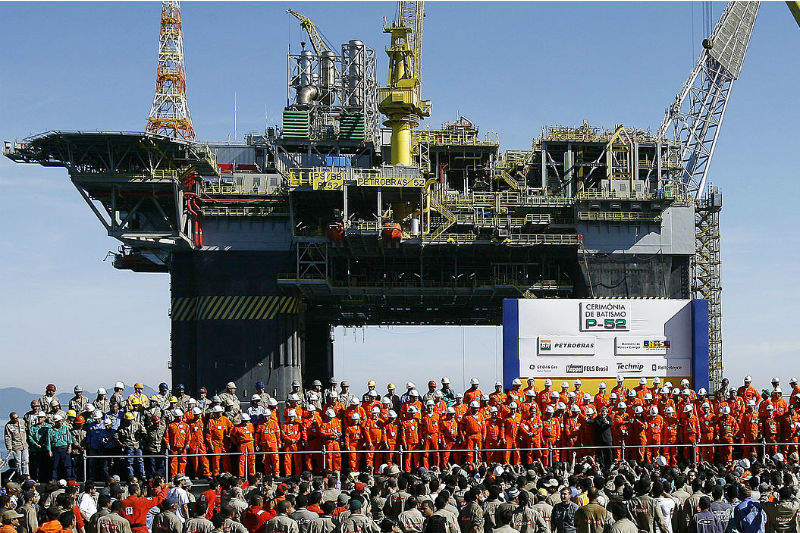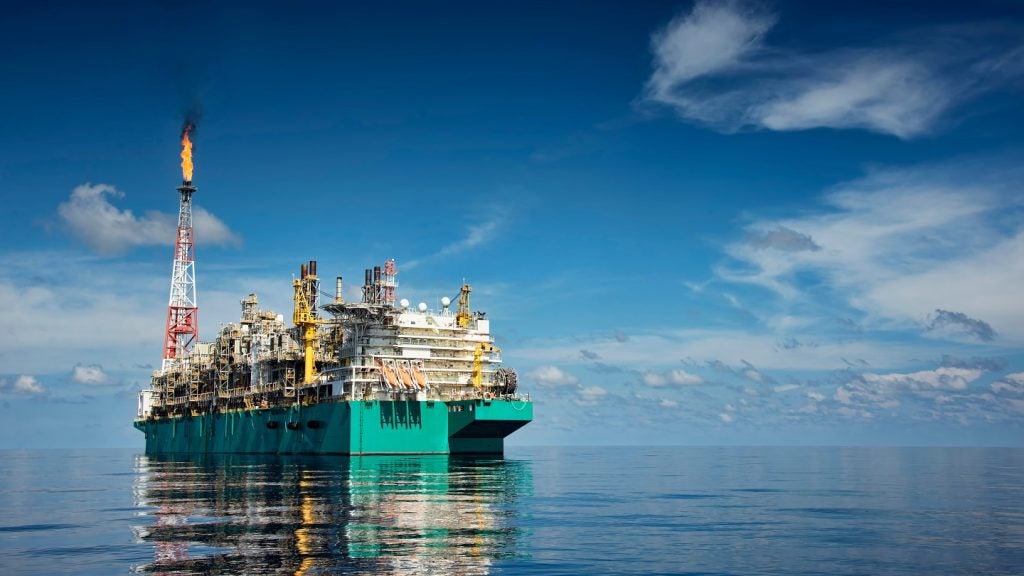
It was announced on Monday that many of the major oil giants – including Shell, ExxonMobil, and BP – had come out on top in the fifth round auction for acreage in the Santos and Campos basins offshore Brazil. Pre-salt oil reserves in the basins contain 16.4 billion barrels of crude, according to Petrobras, and total production from the region is estimated at almost five billion barrels in 2025 alone.
How was the Brazilian pre-salt region first discovered, and what is the potential for the oil-rich reserve?
2006: Petrobras discovers first pre-salt oil
Brazilian petroleum giant Petrobras first discovered pre-salt oil reserves in the Lula oil field in the Santos Basin in 2006, and drew its first oil from the Jubarte field in the Campos Basin two years later, in 2008. Since then, the pre-salt layer has proven to conceal larger oil reserves, in a series of consecutive discoveries.
At the time, US equity firm Riedel Research founder and president David Riedel described the pre-salt region as “one of the most impressive oil finds globally in terms of scale”.
Petrobras soon found, however, that drilling the pre-salt oil region was exponentially more difficult than exploring post-salt oil reserves. As a result, companies were slow to prioritise exploration efforts.
Brazilian Association of Petroleum Geologists president Marcio Rocha Mello told Offshore Magazine in a 2008 interview: “The [pre-salt] results were satisfactory; with oil fields such as the Badejo, Linguado, and Trilha, allowing the basin to become even more productive. Later, with the discoveries of the super-giant post-salt Tertiary and Upper Cretaceous turbidite systems at shallower burial depths, the pre-salt petroleum system was put aside as low priority.”
How well do you really know your competitors?
Access the most comprehensive Company Profiles on the market, powered by GlobalData. Save hours of research. Gain competitive edge.

Thank you!
Your download email will arrive shortly
Not ready to buy yet? Download a free sample
We are confident about the unique quality of our Company Profiles. However, we want you to make the most beneficial decision for your business, so we offer a free sample that you can download by submitting the below form
By GlobalDataHowever, as the post-salt oil reserves dwindled, the Brazilian oil giant kick-started pre-salt operations.
“In recent years, due to lack of remaining giant prospects in the post-salt, Petrobras started to drill deeper, more than 6,000m (19,685ft), looking for giant oil and gas accumulations in the pre-salt province offshore, including Santos, Campos, and Espirito Santo basins,” Mello added.
“Among the major hurdles to success in this new exploration frontier was the challenge to properly image the pre-salt targets, to undertake drilling through thick salt layers, and to evaluate high pressure and temperatures.”
2007: the technical challenges of drilling pre-salt oil
Despite the first successful drilling campaigns in the Santos Basin, other offshore ventures in the pre-salt region encountered problems, especially in the areas of well technology, reservoir technology, scale, and flow assurance.
A report published by Research Gate in 2009 highlights some of the more prominent challenges.
Most notably, the thick salt that traps hydrocarbons is inherently difficult to drill through. The rock that makes up the evaporite layer is composed of different types of salt.
When exposed to drilling fluid, salt can deform or change its physical structure considerably. This is known as salt creep. When drilling through a layer of different salt sediments with varying creep rates, the salts with higher creep rates like carnalite and tachydrate will deform faster than halite and anhydrate, and can cause serious issues such as well borehole closures.
Other issues include well case-bending, precipitates clogging drill holes, and a lack of adequate lubrication in pipelines. To face these challenges, Petrobras created the PROSAL programme in 2007, designed to anticipate solutions to these unique problems. R&D projects began the following year, in close cooperation with university researchers in Brazil and internationally, as well as oilfield services experts and technology suppliers.
Petrobras’ early success in the industry would be safeguarded by the Brazilian authorities, in the form of the Pre-Salt Law.
2010: Brazil introduces the Pre-Salt Law
In December 2010, the Brazilian Government enacted a new piece of legislation – Law 12,351/2010 – known as the Pre-Salt Law. Under the legislation, the government established primary guidelines for exploration and production, including the endorsement of production sharing agreements (PSAs) instead of concession agreements.
The law named Petrobras as the leader of all operations in the pre-salt oil region, in which it would take a minimum 30% stake. In 2013, it also established the public company Empresa Brasileira de Administração de Petróleo e Gás Natural (PPSA) as the manager of all PSAs, and required all foreign companies wishing to drill in the area to join a consortium with Petrobras and PPSA.
Foreign companies could only drill in the pre-salt oil region provided they incorporated Petrobras or the PPSA, and met the technical, legal and financial requirements established by the National Agency of Petroleum, Natural Gas and Biofuels.
However, the Pre-Salt Law was heavily criticised for hindering the oil industry’s development, and Petrobras soon came under fire.
The 2014 ‘Operation Car Wash’ scandal, deemed the country’s largest corruption case in history, discovered that Petrobras was taking bribes from several major Brazilian companies in return for awarding construction contracts.
Furthermore, a long-term fall in oil prices and political instability in Brazil have all contributed to Petrobras’ woes, and the company culminated $130bn in debt as of Q4 2016.
2016: the Pre-Salt Law reform fuels fresh bidding rounds
Calls for amending the Pre-Salt Law of 2010 were heard in November 2016 with the inauguration of Bill 4567/16, in an attempt to encourage investment in Brazil by allowing foreign companies to become operators in the region.
This has led to an explosion of pre-salt auction rounds, together with Petrobras’ $35bn divestments across certain fields.
A primary objective of the amendment was to release Petrobras from its duty to hold a 30% operating interest in future projects, but gave the company a right of preference, if it wished to participate.
The government still exerts some influence over production operations through the PPSA, as the public company would still manage PSAs.
In the last two years, five pre-salt bidding rounds have taken place.
The fourth bidding round in June 2018 offered 4,232km2 across four oil fields, and attracted a record 16 companies. Petrobras used its preferential rights to maintain a minimum 30% working interest in three of the four oil fields available, namely the Dois Irmãos in the Campos Basin, as well as Três Marias and Uirapuru fields in the Santos Basin.
Wood Mackenzie senior research analyst for Latin American upstream oil and gas Juliana Miguez said in a press release: “With industry heavyweights again leading the competition, Brazil’s pre-salt has consolidated as the playground for those with deep pockets. High interest from a select group of companies and strong competition in the rounds are a reflection of the prospectivity of the acreage. The crown, however, still belongs to Petrobras.”
For Dois Irmãos, Petrobras took a 45% stake, in a PSA with BP (30%) and Equinor (25%). Petrobras also took a minimum stake of 30% in the other fields, which involved companies including Shell, Chevron, Equinor, ExxonMobil and Petrogal. The final field, Itaimbezinho, received no successful bids and was left unawarded.
2018: Petrobras snubs preferential right for the first time
The fifth and latest bidding round is arguably the most fascinating, as it is the first time that Petrobras has not used its preferential right to a minimum 30% share in all fields.
There were four more blocks on offer in this round: the Saturno, Titã, Pau-Brasil in the Santos Basin, and Sudoeste de Tartaruga Verde in the Campos Basin.
All of the fields attracted interest as usual from the major companies. The Brazilian Government subsequently made R$6.82bn ($1.71bn) in signing bonuses, as well as an additional R$1bn ($260m) in planned investment during exploratory phases.
Saturno was split between Shell (50%) and Chevron (50%). ExxonMobil took a majority 64% interest in the Titã field with Qatar Petroleum International (36%); while the Pau-Brasil field was divided between BP (50%), China’s CNOOC (30%), and Colombia’s Ecopetrol (20%).
GlobalData oil and gas analyst for Latin America David Bautista says: “What is interesting is that in fact Pau-Brasil and Sudoeste de Tartaruga Verde (SOTV) were not awarded one year ago in rounds three and two respectively, and now these were awarded the smallest signing bonus of the four blocks, namely R$500m ($130m) for Pau-Brasil and R$70m ($18.2m) for Sudoeste de Tartaruga Verde.”
Despite not taking any stake in the other three fields, Petrobras acquired a 100% interest in the Sudoeste de Tartaruga Verde field. This round was the last pre-salt auction before the Brazilian presidential elections take place on 7 October.




